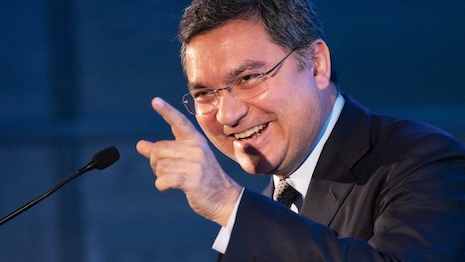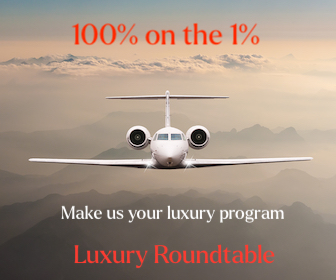A Luxury Roundtable white paper
The slowdown in luxury consumption, while not uniform worldwide, will likely continue into the third and fourth quarters of 2024 as the world grapples with economic belt-tightening, geopolitical conflict in two theatres of war and a weakened Chinese consumer market.
Luxury groups LVMH, Kering and Burberry reported drops in net profit for the first half of this year, while Hermès and Prada posted positive numbers.
The Chinese customer, always reliable for her spending on luxury, is now saving at a furious rate. Not only are there fewer jobs for younger, aspirational consumers, but the speculation in real estate has led to the bubble’s burst – taking precious savings with it. Add to that a Chinese government crackdown on ostentatious spending.
Clearly, a tale of two cities is emerging: luxury brands serving wealthy and UHNW clients are more resilient and resistant to buyer pullbacks, but those relying on the aspiring classes in China and elsewhere – who have curbed discretionary spending – have suffered.
Resilience at the tip of the pyramid
There is a shocking imbalance even within luxury brands relying heavily on aspiring consumers as the bigger, more deep-pocketed players pull ahead of their smaller rivals.
Louis Vuitton’s revenue last year almost clocked in $25 billion, and Dior about $15 billion – pretty much where rivals Hermès and Chanel came in. Even Gucci, currently undergoing a dramatic drop in sales and profits, posts revenue in 10 figures.
Where does that leave the rest of the luxury market? Scrambling for consumer attention and prime retail locations that cannot rival their well-heeled competitors from the LVMH, Kering, Richemont, Hermès, Chanel, Prada and Swatch Group stables.
Feeling it
The bigger luxury brands are investing in delivering unique customer experiences because that is where the money is moving.
After the stifling lockdown over COVID-19, consumers are still making up for lost time by vacationing in unique destinations domestically and overseas. They are also eating out in record numbers – all pulling from budgets that normally would have gone to acquiring hard luxury goods.
The luxury business, while relying on classic codes of quality, creativity, exclusivity, craftsmanship, heritage and experience, is also the ultimate shapeshifter, adapting to the times and generations wielding spending power.
Brand collaborations and cultural alliances are on the rise as marketers look to align with peers who share similar values but different databases. This extends to not just partnerships and alliances within luxury goods but also names on residences and hotels.
Louis Vuitton now has a bakery in Tokyo, for instance. Most luxury brands want to be lifestyle brands to capture a larger share of market. Mercedes-Benz and Bentley Motors have aligned with developers in Miami to plan swanky new residential towers, adding to the Aston Martin and Baccarat residences.
As the younger millennials and Gen Z generations enter their peak earning years, the brands serving them recognize changes in purchasing patterns.
These cohorts prefer experiences over product, contemporary designs over staid patterns and, yes – they still hanker for logos or signifiers of tribal belonging, however overt or subtle they may be.
 Hermès is seemingly immune to swings in consumer buying behavior, insulating itself with an emphasis on quality, craftsmanship and creating desire. Image: Hermès
Hermès is seemingly immune to swings in consumer buying behavior, insulating itself with an emphasis on quality, craftsmanship and creating desire. Image: Hermès
Emerging classes and markets
Worldwide, the number of consumers entering the middle class and the tier above is on the rise.
Take a look at the new wealthy in the Middle East, particularly in the United Arab Emirates, as well as African countries such as Nigeria and Kenya and Southeast Asian manufacturing centers including Vietnam.
India is spawning a thirsty middle class that yearns for German and British luxury cars, homes with the most modern, upscale amenities, handbags from Louis Vuitton, Hermes and Chanel and travel to Europe, United States and Southeast Asia.
Japan, too, is a consistent customer of luxury goods even as the stock market swooned this week, indicating the pitfalls of a strong yen.
China, even factoring in the slowdown, accounts for one out of five global purchases of luxury goods.
Indeed, the number of millionaires and centi-millionaires, not to mention billionaires, is on a steady uptick. And once they have arrived, they want the world to know with Hermès Birkin bags, Louis Vuitton totes, Rolls-Royce, Bentley and Ferrari cars, Chanel perfumes, Rolex watches, Manolo Blahnik footwear and second homes in top resorts worldwide.
What luxury marketers are selling is not product or service – they are selling desire.
The question many folks ask is, will higher interest rate increases affect luxury sectors other than real estate? The answer to that is two-fold: those brands serving the top of the pyramid are more resilient to interest rate hikes while those at the base are more sensitive.
For example, the affluent and wealthy luxury homebuyer is more likely to pay for the purchase with cash versus a mortgage. Indeed, half of U.S. luxury homebuyers are cash buyers.
The recent global dip in stock markets means that the U.S. Fed will have to step in soon to steady the markets with lower interest rates, not just once but many times, to prevent the world’s largest economy from slipping into a recession. That said, U.S. fundamentals are strong.
But keep in mind that a large chunk of wealthy and UHNW consumers’ wealth is stored in stocks. That unrealized wealth could shrink if the global stock markets do not soon stabilize.
For the upscale, diversifying their wealth has been a long-held objective. Other sources of wealth beyond real estate include stocks, art, wine, watches and branded jewelry and Hermès Birkin bags – they outperform stocks long term on the resale market.
Among stocks, tech giants took the largest hit this week, but it is worth looking into self-storage unit companies, who, as real estate investment trusts, have to ply their shareholders with annual dividends. As U.S. consumers continue to accumulate products and hurt for room to store them in expensive cities, self-storage units are often the answer.
 Mickey ALAM KHAN is a luxury marketer, luxury events producer, real estate brokerage advisor and former head of a leading luxury real estate network
Mickey ALAM KHAN is a luxury marketer, luxury events producer, real estate brokerage advisor and former head of a leading luxury real estate network
Going tribal
Here is the thing about the luxury business. It has withstood wars, pandemics, recessions and depression, as well as changes in tastes and wealth centers of gravity. Those brands with great bones – heritage, quality, creativity, exclusivity, craftsmanship and high-perceived value – have survived.
For a while, it seemed like “quiet luxury” was in the ascendant, particularly after actor Gwyneth Paltrow’s case a few years in Aspen, Colorado, where a doctor sued her for colliding on the ski slopes. Ms. Paltrow showed up in court wearing understated but classic beige, browns and muted tones, sourcing apparel from The Row and Loro Piana, among others.
There has always been quiet luxury, associated typically with largely logo-free brands such as Loro Piana, Brunello Cuccinelli, The Row, Celine and several British heritage brands.
However, most consumers, including the well-heeled, veer towards Louis Vuitton, Dior, Hermès, Gucci, Prada and the like – all unabashedly flaunters of their insignia.
After all, luxury is about belonging to a tribe. Consumers signal which tribe’s values they align with through their purchases of luxury fashion, leather goods, cars, jets, yachts, jewelry and branded real estate.
As luxury marketers look to grow amidst market challenges, they must seriously consider brand collaborations and partnerships. This is as true in real estate as it is in fashion. Tapping each other’s audiences is a quick way to grow brand awareness to complementary markets.
Another trick to borrow from the LVMH, Kering, Cartier and Hermès playbook is extreme attention to very important clients (VIC).
There is the old saw about 80 percent of business coming from 20 percent of customers. It still holds true, so nurturing the big spenders and offering special services for customer retention and repeat business is key.
Another area that needs attention is training of the luxury professional, whether it is the sales associate in the store, manager of the boutique or luxury real estate agent. They need to be constantly upskilled, exposed to knowledge from experts and peers, and network with likeminded professionals from their industry and beyond.
THE OVERALL LUXURY business comprising everything from fashion and leather goods to watches, jewelry, art, cars, jets, yachts and real estate is going through a process of normalization of demand.
Some sectors such as travel and hospitality are stealing market share due to an affluent consumer shift towards experiential luxury.
Yet, all sectors will post steady growth over the years only if they remember what got luxury to the party: a strong emphasis on quality, exclusivity, creativity, craftsmanship, customer service and heritage.
If luxury is reduced simply to a brand play, there is not much to separate the business from mass-market products and services other than a higher price tag.
A smart luxury professional realizes the difference and focuses on building a long-lasting relationship with the customer versus a quick-hit transaction. In luxury, yesterday, today and tomorrow carry equal weight.
Want to know where luxury retail is headed? Join us at Luxury Roundtable’s Luxury Retail Forum New York Sept. 12. Register now – limited seats.
{"ct":"OEaZodnJIsANI5aKmwBc+tiQnMOiv7NzsZ9stF96LaadlpYLPvY8oyBVT6+GzbVa8OTCWCG0hellFIZmeCcrYOjD\/4lhnhAxBA+mwGheXXpRsinkJO2oE86aV5AHRr3AtC9NBbfZuZGhSkqWzKT9lq2OHfLQlhyljZP8xrdRefHWQUwuA3dR5NHYIig5f6slPZ\/9mPeNvivW9v8nOY3HZOKFxeRGWBaXnDojapCFcJfCKtLYldj9G90r1qSgaDxusBJQ70GI2ZNBlzmAku4Q1d5V1ErKUw0AObokOPZBca+ISsbFRexcS+aa0RUj6\/R5fu38\/yTVHP7bKUl0ZU7za7yAOJYp3JHbk9AHGjT4dFRHm1L18UZwxahGZNvN1DW32WuE5Y9YGVvnvzsMdZjYTrTNGJwTXjjjAhjB0LzypIbisjZBvLN0PjLSt3DwNX06GeHnuVcQMtY0rDRPn8M7lCTs3A+KV0XFycctQcPLQAzJxpUia2yGN2kgG5PKOuFUiTGZGFk1ttbTJcKeho4MArXWTdvxHt6hbpVttbR5UIzBkILLGKO1GmVQhNxIBDIgpVDku6tS3aVRNir7Cx920QfErGVdcZ8Wtw7kkTx11RCDd0m0DzcK+23xr\/E0Gn\/JsMB4ECBh+AE7xZFSw1uvqRli9yTDA+9QlbXGrn7QNU9x3EqNPuL0w4lPAKj+sc6Mdm83cZvnyNzVQ0DTeY+AP6vqAYykN1Vut513VtC3hqxnmXqnHtAz\/CHFLmiUdf4OeHjyBK1ESC+UHumqImMIxttTQrR+yfL6mU9hSoK7vTB2xGr+VckZW6LkD0DCSFkvqu9fDgR9tWKWhpbMrLd7ESt7KrK+GtiJFgbFhmeZPKIx11lbT9VROO6scf99EHDIWJPP4njpEbrqMiu\/3QFp4F3EYdN3lzQcyNF6n\/OouIdIMXmOmESHZWuKBuwNNCUgGPap0mmEPRdOmI2BjWMKDQvdoIMDlOF3TkMB7ga4aZjsN+szhtg4mn7EJdaeGH7tg810O3t0GYvhi9Oa10WVnMNJsAdAbqOjYT29yk2jWNDnxOTdxLcsD322K2zbn8df4zQaTRSMNkdAfFSeIXcLVTnQXZISswCTl9+\/qpGnuyKe\/oKq0PQlIW9Jpu5XAfuiImvUt9wz0mhBmh9u8BGf6HVSIXHcQ2j4ynVNKSN8p8n6ZPRBuVtl2MNT399xoeC5H8mJx5XitRhSaNHEb+LmvxEjicIadxnj1Ysw5hWE7RBNc6Clsf+NHleEQT\/3zG0QHJgTJ356YXwWk83OM+WCe7fCQcBTIhEdj\/cnDc4BXD+l4QKT63k2eE0of3XHHJ79g3A20ZgGufLFgVBS7DiG6qNgM9JsbKBdc9JTuoJaZVWlNERJDWGhjHdr3DUFnUqH+0dsr2Se1heHYSpMucSAiqLjrXCUoKlnddIRIJQd27\/GFDaCk58LnhkKfmV9yg7EIzMJzkMveoBSXAgVQZzBOB2dQUhfwNpKz65GqTnKUAOotigtStgdxHB5gDsW8nUl7xJQlSJCxJiNCve4ggxPEvVd\/gN9YAVpv2kayRJx4bjzTyUzS6P4mY0UCygVrCuZBbPtyfOmzRMbmlkPVO46GDNZ2iiSCH6vUVJc0zazrAyUnovaSAy4fVSf80xWqD91x48PLFcuHI2M55fnI+CCPII\/wOpqYjFRE8AXui57435Z7lB0SrKe0+kaqSUUelyZFJ5CFD0r4idtS5f58Q4sOC9fBEZqcebq+53OEsNsFu1Hs4OLQqtG6h3pVgid5zHiCJNH\/SQvRXCIX6iNL6qJQqS5UuuN7Kn4jGUcTAVaSsRcODO4RwfebW5ITAN9xXFpNuGGeS78t+jTVBIF4GjANLPFxyeSacUKt5e9O0CthrB+GpPoAOODcAA0e\/oE32hkWwjMKte\/OJAQcg5tGpqy8xbfj3PPMSDxi7pTYb\/XEEyPmHvY+CCXDPj9ZF\/g9pmlCmezPI+CNkAAnfEyoq6DO50JzaRG25FhTyooljkRSEoQgUVD0fNfrsxU5gHNUsrcNgtS4F2TvjjgQESHjncysHkUe8zZIiOIIEWN0uYITRvLQg9FPCXGKlvjl+ZQcE28q0AJ41eWkeNvUlaVI3xrHsJYrNo571DkUaBnLcrD47\/5wWf1qVA\/saeUz3\/NlxQ2MK2G0Pnj7rE\/7VJHxd4XvW5ngfAc6jocL6dD4BpbiyGYbzRN0XFPU\/gJgbpksi2z\/fsPqyGA1Ak+axD+0XkSFs9TdtMdh9WV+NJuOoOfyc1\/QV9dRNC1DUZz9\/oKWxVSoAQL0j9aUeV9vWfWFnootyHZgjJ+igQZx+tM7AwtslISyk\/CVUPXFNaFfAEwxG71LahBd8HLMn0OPs0sERGBUgwkEk6lQF4hUWxs6AFW\/FwP07wL7kgYJa5YuWbkrkARLc0SWviBSYnzI3BUBBZvuAyInXTFc9MmR8nCFyv3GEjlEhKYhRSkyQBCjdbTkNKsS9PhWYR1Bfu\/f5eLZsvxpPOPpUmQm1ybANrpgRHuDw5nrWGG9s8rdNcoKRJpfp8MwfFwDUgD5xSfPD+GfwUgHl3YG8aDsAR58k5QS4CKG4jxdksatsAnkU+B4ugQO+rVcFgt7CaoPIr9k12FlTsIj6fs0PxtDRDgXq48qhGgx7SIh5IfFqEVp2HNMixfVBpkhd1xEmUtcBjpiIavcmHIIh0AyljnD2mXI+Ekx4RRbdse4d1EPc4Tlq1dBFn+0PvNol6AAGbyg3CTl8rNew2F9IJYU4PDEXIgzsEZA33\/uE+AlHY\/Rji8yLvjN0ZqrO5GfpT4dwGw3P8Q0LMpfpVi1Yzx5y1TswaqCMpk8IcKzofdjb2WSHS8nJU2B2kQwo53aRnBux21ORzvVJWuk4KaXuGbp39s14hmCA087WHI\/c8Oo09D6SgIleVjNc3RxFqiu24I\/K+1ToNI3e+vF8\/f5wB4y41JkyVs6Wt8J8T0+3gUQGHpMlEP8t02Il6zdOrcXc+0nfIIGv8bjmK20oPjHAD4azO3aGlcZyXMAnuETfh2\/O0EbUcCCseYNcmWMhyGKhIULLb0Gzghv4hDm4Uy6jBcUh42EMOKac++jlfMNarknRPhw24NCrWUbjdwlQaXWghF65m2+5Mjic0tfTag14Ewf1xlXRV0AS9htN1UJ6BuNfp9Y2w6vdJDtRLAWEnBA0hS3BY2E3fY5FT3X6PVBagN+WcqKDUA\/SQga1ydjwguJJux\/8nVfYQH+Q4lvfxjQ35+Egfw\/TOuOyMmulKER7sqmo069K1wt0H9M40U8GxzXKFLs5JanaRK11tryqsHHagk7wyWxPmQIAtbTxdjcgSW+81FVEDwLoIJGGPoq+SOEInLflSp1uBYeMGzBS8UP4GB2bE5K0GyIFkwZIoknYnzWG08A\/T4xJ+a0BpCApaAXRYgP2tZQp8qh3jA0612NPInkGDBn\/TbKqMh9uLF24QvyPAGf0upSBB8WSWeze+1jaVdZV1CACmSycp3y857nbuGb+9mU4A8kYGdqGknrKFUiFQLl0NlNe\/oII2MqQdjET5izjXs0EtJrclmdmdp6EISUkfwDvQaiFIG3CccC0koMlSFEt+VVWWptJXN0XEbGEVBUkpimQguoc5wrWVWGxDjs8XwPpHO\/8gYli2kmxk2vlSDWiTAmHEOkiefpO\/bY2Gq6eeLMXEGEJpN70Qwl\/EmW\/zqwaN4s4HpNZxH0Wt9F9eCKmuZI\/k2xvboNtuqhoJE0eSSudiYQxU0Dn96PIGmWJsa5TS2nHQOT5K+gsUOpv14RHaZc9klCXhEFWzZZ093mqw1sR+0KezjSGKqSfHd\/ZmxkK87d9iHwPSJ92gW7UE8h1kzD9yQ\/dlBzK80EfsyzHhfkKap8EKyvoqfD5CMWQdNnkF\/tXxqLzBTXfWFYQxckdQYd1n7q4O7ndcF5c4mrArFDZJXzwTwXetsgxHq0b6yKYfiB5gLBS2XyLx7tHNYQ\/Qa2eVoJe+xHSBa2OsMBK858DBYozqZYDMOZM7soJzBxMAtzHtSlx7nemfnxrWK388xGXJX3CmhgEK33\/NCDJytoHnu3z9ZkzgtyICBfmxR3EzhSpxH6LN70gH4qEsL+vu7vbNvwSC8chr8OlFnzs10pnppkA0DtSWUkuYxfCdG7TI2puJdKxTQfz9QqhI+zsHu6Wsn5K+JGedZyARo+TA+SZG0zgHwUO5oA85NKvlyMSBtdH7GGV6eLCRnqkBAglTmO3FEh4AGwX3yqWhPy3XKLU5VFL6fNUAp2YP66bZ\/KYX\/aTOwDoon6kOE31pELgIvGRPbemUCqOGWAVDOIwldmQ+PHPUe5aF5B9aVKM+pLlDWYgAcRFYH8bEkhv7G59St9\/3NavZDFQ4PtPbvjBqSlOGvJ3t3M07xnr94CIo+g53J9oUrmJS7yocUSz7Ufupp94leuPlLgw7FCutjN+ABHYOdFge\/wc\/Zc62OfSIRFOOIPO\/eQGCCJtwPtNsoPoDgHTq1mRZhBobO6HLUuMp7eMSSl+Jr2dLO128ZcVonRaxVDNe22Zpa7ntedQbdkihBVEkUZ\/ewkLdc9yrPiNjHjWQ\/oAxkklsl1+Lz5Qp4efIh6LrhL\/ZZa\/S5Y+6IIR4gkSnvS6HxQVaivTYjf6a2v6\/mU9PXkeX8jzerMR5pyivBRoE134ZChH4V4PbEY+PHm6VePqLWKRsf60zK2O9scUo9Oent1MgLBBINI99bTddweun+y0k2mwXq0WqiFMtzmHEN2z8WwjfIIWjZZ9I8cRFKIGFRiqsBXyZITBbazvtqVd+MtSIWWU5gSomVO7rAQM9VYT2RwgnDVqmksK2VtsJWikgllL04sQ5c3IBFaVEhNBAojfTs2e3X\/j7C6BSxvGs+u\/bDljs43WNZshi9bxLzfkMt+syiwG\/LmoJDKZgMzOJknaJ\/haR6GoFobBc02HxVGtEhT4HJqL9cQiS2wHSn4FwePuq12mm3eJouh4M5fDVzlnEo\/dN87+zOuweC+eTNkIKK82cDFXmIFTxG\/u0o52FKTc5NRVYJdia6du28i4hZXN9G3BbXxxaBS\/fJmEhSWNifd6H5IeFLhCOoEdJ4Unoqft+1cQrt3NmSRgIDZnbOU76cUG1dBpNAUK1+9wHlek9xvxxAulSi+5kCFE6o6twuKR54n+AekCrjwm9g\/irdzLleompHEPGRY60jWa34GteXxQ5LBZp3XnTOmGsV7c3MIFYF0zKU0ZEHlPRvpF9Fz6oUpyuCIft5u\/xmy8rPvbtwWdTTta5h5FTG\/gl9aPLit+zFhWVKwNdkOTdddXzD3IH3cTfpan2HvsruT1IcPDYaUpmqDlTFDpHpUeFkkTLbeGE2ThQMWNPMUMDK4hIphf9f+ugWd7zBydpkkPFAPPg1MrN1\/\/XAC6oJv38S9nsYzIXwlgdu8BCy+MgJh+7zutP8aiSDErTwEh2obNSnUUuXE631QAlQvcOWiGkmEwdMRna5Eca81F4ZoqGibJm6+PTo68lZ74DMPLogVOJkhoX0UPO2dQt0\/x4Q5LqKj1ApuV3aNf0wo\/sG46ZZBTorjIS5eNIND\/FnCdEkTfJegxGXtazqD+ZE6\/AaqgLVP0JXJhgBVHgyoYfJrgXkAT17zvpogHncaL03z3kRlF7EYRpJVfb5anQXJOxe6AXuKdMfXJCFDX4oHs2lWccwAOE7UgeS6IpAHKl76HNpyYrVlnEft\/H+NVODOxXOF5KsD3I7cDFcRbTCpH8fNNmaw6IX68jUfSjlhITEF3cO9OjtfB8\/iUcbbzVDEUp5BNz5L5yQyednWGHgDrGKJl1t1Psg+LkIx6wcL5cSXRz0mZA7EM19i+BHCgkR+xeGT5\/ui3jaBSgZatJUJzQn58UK8l9IFjn5frRWF1LHQXyRyxoq01BXTIT9vWvsjg4z\/TF9XK06hF0wyBsyBX7xXr5d5uso4WM8csKUUf+ILVj2iTveWscbqDd3eoY1WiGnqPLWPWwqOs8+wvgEO5NefPcgoYW4XWTiz8cFraRQYuJOWPw7crq47WzNOEwRQnv0qpNBgmrU8Dn+Y+nHxXXhioz4G3KSsQI+aKPInn5EzMd\/amb2JdxwryuWuDxeipNfg5rmqqQJznOzm80nhkeulKC4H3rubiNRtlEEijMt+YVYSXwB8vJNG\/5Qgj04ZtJHqCep2aIIkQI3kPwxiiYFuIEpqBwLUF4JdEia9TApRZI4tK437HxdNljkzbRkPNIkIPQjuTEjnFG+po9OoFhD+t+2C8h9UiS3Jbrgf+cX8IHxAfTaIgTnFlNWGiDSt+6PBdHTvv+Fb+H\/Y0PGZN\/\/\/r4hQujzAMsoDSx+q1iITcn+7dzwtlZqhexp2kJH02iYrEE93Lt+ccaohS3KJ7uXUdaUTCXn6zLYiqdeRgHJTK+WhXfhkmA7DRHY4wVYJcjrXorAfGlfFBIioPb8imjUjdl3Z+bi124OUAEDzmO7VX4aQi9jyl40256UoOrFMnS6W46jZan3O3tAlOXkEyuZg2Lq7WDX52L0kNunnQ6wzlcAHrI\/QUo7p3nmSWV3NdL1c9VJBlfAa6qD\/DjhFh\/OLOCv\/oH8ZVr8bH7pGjPNuli2+i1Gu57jFnvxNhrzGr1M69+cpJ7B2jcaHdaYrhDfQ0E56p2bNsfuPqRZPggOQC357mOg0Sl9DJH330TJmjXO\/FPs8dbrdx76bO2cspXZPJvo2f2mYXRAsi\/lGbdhuljB2DjWX+YJ5+hzEksECwzh7JiKTQrgEXFGLPXp40hSvbT3lnzaT8StRtJM7WLRt7B\/Q3SYNb+80DnHWB95Po1l963\/LNetOtpg6I+nfQTw8z\/19mla81zPXqtrhMSERjZy7eUUeuRzVMHFyjZuIeXGG\/20lSjWOURLJJgMq+ZuR2uJtl5Lyt2xjHytMOFanbjn0ucZzJSexHJYAJeyMOJTaWM0LuUafjW0FRKTwmViUiOpcXwuGWXqfdjRvjmTeU+gtxqskIcMQcZMCd73EnhAP17czuMQHpGzYRvxUAUmdwuERq0cnO7kG0+f191RXyZAozpRZ+ZnLW3Raiw68nTo+p612OZ4IZC9p39O\/xpp62hYQCfVSqDwacQKseBDrfkMu988XDfvwYEXZzr\/jFdlKt5jpGS4SeSMS3k0g5\/wZxAoScuLqI7aOErsjttBMA5qC5nocAJTSyiYt\/p3XNpyUIjsiae2mB6QNZLPJnzI1u2ulV\/LxHsKgM6QiJcuQ\/upbL+WE9eZSlKfwi01W8qKEFS5DmqExHGMFMlRujIwwItF6CM3Xq84\/RxPCvY28Y+LAuBxc94ATc6pJOYXjRkWfvBDDjw9MoAQf6K7sN9TtEBKjz7OiI+bOXBh2svmBNFc09DI1rrcGp5D4BgPdIEFQKLvhsyW9c7Bxa0WB2HAAdAb9p6c6o0+IoYVKFa8aQoO\/aMAlKLP96Oa++8lk86TSg5iqdA5UqJlU8h\/K9VFcDBDd3SPrblSErjo01+6NAf7jLrQ8VXQhU8DxcR\/4b6ib2UjIWNXdvOsfXCKCq6wzCNYnnfqsTOlmxoqMqL14ZDgapyHAn1PvbwUEInMIpEOMQAAToxylXZzuniGDg8bvgDBJfopVQvHhXSVWiX1XXjwQ0glo4M5p\/4VkFkvSZ3i5vlge09QEuGOQc5H4q1ztKtBF\/TIKxtNrzxjo\/ht8bT7WIsP8HiTzzAeFOkvHsK4Og2ciTTGHEf1FgxAVNH1SVvBeJfzdZ7aA5SVtXojF02+13kROOlcYYhJLOUY6J48kZYDT4I68c141gRWieozp43WVq5o2vt3EMte+DmsB6NcIgcJXfgjWbSkExbO7klXKVMCS+Nqo8xsYw\/tI8cCpVLJrTQ7DKhqkY0qLOyqK0Ub\/WTKlhvZqmeueHvW1z4ajDBk+QP0yAbW8dNFVvC+mx0aRK88aHtggGctuKboZeSBkJBQnWJandOW52edCwx0JyZiGramnAKUVwXJPs2gU1cJOvjpFrIuVkzrs+puAjINj2MNeS4xwee+nitdNM+8GMP+4+JKLGI2WPCroX21pI3DtaBz7e1JVGa8ExsiSt4ADMuV1oRBf1b58k7+C0tJKA5VfYAQV\/lIiDvJwF4EDpwQ41e+++4NZbv+zmPvW9GN3bcm9LpUajcqn7Q4rd5OIQP7BIzzIruKdCnkud4IoRrEnvASMuupNHlREXep6Bb42AbaaqUwZCCfKDaDNukYfRs0DumjpOnV9SydBqD7MmKJ6aa6VbbZs27+21nQdkA4cN4GH5\/G7lPclgnESY2RRjcRfFUuAu6HMhdhwlm91\/jjE71eVFq+xFM4rzggJZIFSYxuuW1Z2cX6ZXOVA5ZtVWsGzflmYLKQYbHflE8sEX2e1Fn2USWb2QC0Kd9BcSXMYN9bhInVQk25qewrdL5uQPHrY\/hkmWJaenaX\/OiiYwtuNqXadLb0vPPhDrPKUBja+mvcFEsNjCWfUtc4Xgc1IJoO+5DK7GlMxDchFxKayMKslDugIbBLGIj2BlW6qwqp7XymcOFy\/oZfzWlQiD7hShhSh5DJuckPvUev6pH0XqkMOMmkLJL97cdsN7YbYdX33aAAiYH5GoLTizk4x1031+YGNQlu1DGWsk\/clON0fOgUIO2Wxa5kzqwizIds4dxOm1Q0TqQKJXhRfMqozGvIewAx0U1aulT7rSG6SKnMhtpzuhiiDGZ2KMgtE5V596cM8FOMCX2IpdkSrhpaeWxNVSt\/QekjcT8oAMqEP1EAV7lOvQHqxlivxs1na9\/ZnlVDUa\/5b2+SVwmb0ftxm3pE\/zlRd31lU1Izf4LBQzae2rWkyt+oiCkjN6TE3rChhKCXM4DYrpRavKX+kRUEAaiWRHpiLBeeEG6wdTmCnYduiMsTNDBjiDi2IiLnRzURRZPRnZaMufFQ\/1o53QcBcD4HEvXqyuN1U5tDSlohkJA012AWr+UdzZ2exM0jTzyFTa6S\/jwGmIGbDQwZUrQC+xUIZtvWA+H7AQHUtvlb6GEaixNyU6SA5QJ2qjLTfs9kHbaMQMrbteKG6mguA8nt6bDzPIUJzl25Y2oMCAvlbVE5hfCOHiwuQ4UzmQWeXzE5HDhfnQEHWkt9d\/di8a2eJnDCyKl3dioIQHAq0FPZxU0GtaiX8i4wEOuYpp16v5pD5oQ4t8gufrlJNPBXeDbnSmh2hNFll4yrFxGjlRDq\/S6uP9RJoVVMmzNEVJNVKCk0+OegZgDU9j8+N5kO+HED5NmGueXEFiSOqHCEhl1JumEfYSYA7yp+zbcGjk6O3uvxmmIdUcIUX6+lAoCA9YxDtAUFS5\/V6l9rtkYgts3lVpSvgYYv0fTzpu9uVAtzsFy5d+6+JZfzjl3bGOe+4oEN9hNbC1kW9joFV3xWlJF0UVh0iT7Jm4en\/6uZSBqJu92EvyA3WUq\/FsEAPcjhEwOKCQRsaRy\/u9R7LN1Zx7IjVqBeOtsccQMFpzUboC4Lr7JYEPB9bqwoOmrt4oC5TXzQsDRTEeLxFearBDJIUjGan2mueinT7zGP8eZ8xsDGgZ3\/42BC8vhadWLgeBMSxl4NxGMU+nMmiYooOXv46xFOLcOfUzkuYUDZJfblMebtMlj+\/C8iJz0lSYFc9iydtbN0cywPFdeY70o4IHjC7ueE4PGUYxKFj+lPV9ICHy3BGMU9CJ9bPGQJgOec0Kernti6tOggpA9jZO\/a6xr3Ak2ey5zbTd01tgY+C35+b8HridKE6Lgqb8RsDOK+vq++DfPBV3tJnFoU7hm61ENJWNJPArLq6dkUkmZSZODOw8jNGRdqR9td6xIsgr5uYrn0YH+I28uHUdEv1ZxTAfj1qtGFVVFXZ4VOUN0cTRuvOhQ1\/yAZxeEUM6mklsBYhj7h7LGAxbjvLmmjTW4s9EXRX0cmaiOi6XHurk3ZuEB69uTlpOmQE6UAS9PuKGwRl1ePKIZuGXyaBOWTuZOuhgksuBQG3aOZ0EsVyMdbYUrjxJtKMi5hac5LfuvbwvJnQSysjlltpVsT14C9ykQCyN25ohpPVpzUBSoTNIUeBo4ObNiESw3t6P8wekObWgBFLySslQuxAy5NzW0xS31eN1osGYcjxGgGwth0Lfp0UdzGE0qEy0eEy5m3JqBV+fbBU9wzvGAGiQdLzx8s7pPwy6wt1X9\/1Bvq1sz5ZFwQGgaH88qZo48t6pVg04pgtKY1YZpEkaJHKiAcwRAGf427C1OnktP75y9cYml1cGi0tHyGSdRfoFV0S24f42vEWlLA2BGr1RaU1Ezq+y5ZTujA\/jJRusfu0PdKteQKZ1QRwxWHt1RbbEG+eaHm43ZYHJiSUkhNNUaYBO6B22Vc\/8yB41oOghrD5YSMwY8o2qflD99YMn4YrqYGHwykREi+8NFMZ1kdowcjcV2fC6SN\/dpBK4h18qTFLSyfTZ\/B5F7rTZmJ1UF+PveXiLc1ifIoJTPMcPESf34xpChyI7CA8FEVzrzy07VYpNt3rJDmLiyQht8k\/kQihSs1R4qGlfqwgyae2KtimlyTQ9tCEGs1iJslESnnXEPRb3DmHdCbMA7496llCSDuOLLU90TUlG6Xd9IXfq0XvA0rVj91kETYj0J4jv3o0tnMzt\/Vftb\/V3qMnGJe84EAhN4Dq\/EmejwKn711Gh1S\/vdy\/vKP+1mR7lQIiMJMDb8FKJG2pIJ41XaRyN\/BPhER8hHzCD3afZJlg22k4weLf2Xapfu8XDoe12+wKeBk+CuzTnH9w0JA4c\/R4Y3VEz5282JlmKCQ+Qwm1VwNZrQu10IVElBEA5Phk\/ldPbk+JiKQ8qmIU6wV5DiFt1YwCTBKtSD9HVOHPVOjc4VqdU5Eu8cm4zW\/GXhqdOuEkqhZ14iCS\/DNPY2rQbsXNfjhhdaFJin5OA19\/ghXTq79NjEHeI7cbOP61sLkbmeCNc3FSBSIYRANO14E+4uGTHo2Pn8+n3tlnC7MQ+6KuBCCUoyyVL+gfDSItWQJ+wQ1L98L0hYsc+nCbiNjggHDg7rYY6qPp3owKxPi1yLjX1YApiUmE1dL8JA3Yo4aSpBKibHf7ot9SB6EuXSNfCPbDkX2EOXFgzc2fGuLDUWrZGyHHSQ5G55wgAIDpdvhTU2r4gfSqLZ+z9eA77ZEmz16vmNkooQK2M8grKVuxZ+t3v6d+zjMIBCcZRIHcMZRy0+8\/BjNdcYNZ\/2JQQy5CASM0updk+NzloSs5K9zTNz3f5v1lxr90jCp69TsRJ+1uDLYdbtpTxfWnb1REwNw\/YKJp4PloQN+y+NiihKUZ\/cNii3SPABPu2a0iu++Epjq0+nWv\/aEiqkCkwpGP15wvDASSoVH9r6igv5MF2uogFDRp6GKtdI1wx+Sf6GCTLrO+9sM+G3IsiNvIuo92FEMbzbXogGIvyIz\/IRr9JdnEu7nNRoBkQ8LSIb5YETp8clIu8OKIHyqqbbnXCu3DM0gZYU0jKu6OQ7cjzjG1K+ppLbrFec7rMhdUwiDVKe2y7j0NmhFFnRvJ57uq2HJt2emCOVadv8p7RKkaGjykBVnNXXyvUeZ+DBTP6PYyA3dNWFN85XrdKHSISVra0h4inL0mlwFneLJA\/UPJTKLnl1JoiwcXtzDcwbD8ctuo3q+oaFPmJoI0x5FuAcKNtCxo9nLJjoXFTneFEIdGDqosdJMdmb9an5OISs+MwIsawOXMOHScW0jWznLkTQwjBW\/VGulgH8H8YA15aQg1uhi1nOHKI49uUwbmMUos36\/QzRALuiinq6ehzB5Shz2sf1cxGyC8NKfdvT27RPtUazcUhAF5nieBR4kNxlE8xezNewxT3JbAeR8i1Cybip8D68bMywHqmCQ8EXMAzrqmqryjuiCanR3j6YhAanxcnevtToArJkuXUlLZeCk+doIfoRoETmEwak\/yCLNIFs0F44LrP\/VUG5oH\/c\/r0KXx4sFPSKbPwEJ5IUnKxauUpM31510YwTH59p0qVjUnk4tYpDDHsLvE5+yDCiJI1fYLdbQ6JfOnxm2++msen5T9JKJOvMVI45X3jxAJ33NjjPcyyqim5yddSd03yZ0pWEfjeNOYSkz0nG2Dw9IvpNf99TNucnfumhizTn5fmE3LL9gqmod3DWQccJJ8KEQSi1ahYs+bnqMfRRorgtLn6Sj1B6KO+Bg9s1Ng+LYQr3qk+w1o\/Bywy7OY8vF2eU1G8Sp8+EsYHHiug6\/Is\/4dNVGYmzQKGcSZoKFnlYdiDdNcUUCX6MAejMB8fkbYDbjMskrHQtZ44NQkUeuDpy1vd\/SqCzoZS9eg\/JItpacbjUHIkd0iHKc\/04eYFYIxSCuguFCE4aRHELfFL+A+Tb21ROZUyjtsukpnhP1gabOZS9+UMO1k85ceNXexZCex+usVoaZnr1DwwGsvsAF6ZZ8CyOCwjiJe7uJGaYg2ST75Z3OsCKmj+3Xc\/td8V6v+zt33UMVkl6x0kQOaIlLvk8iTxc87ZmahzylmxdCQcN30I4aZ6cnIb+TZiQgpsde43swuVbxcnGKjx03zDqdH1khEM10StYgsL2SeYKs5BlVKqGVA5Y1V72sLIUZ02SDkUdXx4PX+m0mC+b3\/FPeAVfyYqMrl8zhN1uSy2jEcTYKGNLhSv6qmgEdQ5ApwRJOJXVCFM\/5wvKGQNTDxUjgoiW\/j+ZuszfTPmgbjxC3GB2znfDCobJouVklHoVnLu2SpNgJzTlU4tK\/4b3CZpkmhFR73ZMaZk1ZX5Lrvl4sBmkMeN\/LSyEwIEPsDwhx5AHoT0VTvB+Ugj3wDtCaJ9nFqXyvu1loevZhzNcBeUmz0Jzm7YK2N1G\/PRWluIdlxgZL+MJnkt+vqmj2FMHXoCi\/B3M8eBniOxXIU4t43jS+PaAZQmvzjj0RL2GwBCKqykJqLKawZCViauDDsp\/6dc8CzdXUe0KsaMR46Q6p74nPOOJPSQAIueP5bRcsWsRNM3TcZV31SoKp4XaJOzhxh9uoe2P1mWrefInMLBhkUrYfEd+pNDJLVfn0zdomz9jywglyWr68JFTE9DP7UA3HOUIBlUqSYWd5i9yLPCp2HdIDlX\/AGx8GSCaNxXmahoOx7csrctYjlcFQQCf37GGmOd\/WaT5WJuLMhNtfW91gbNN6zkW4zJtLXIUE1gORYM9Vtts9RQp8GuwKmrrAHqGb9vTURAyFWpYYKmhkMgQ+1OBJJFF5P5qoctN\/sXPqjBgnGsGzY567o4qYT7\/C3hOpgsv17gSdMmNTzd187HUo9ZWM6UiJ8U+A0uFeu9sUCcrvS414oKfHIEeCoeJR+E+tTPpXyXY4Ex8PczPEUDaAeZo7WncalO6Eu6D9qWzorXGl69q\/UX2DTqULNcD8nrm4EJ5V9HaQS5VFfDQfDN7RTYUd1t4OwN4M7hiDQlWQCNoUATHaLFDPjZuWIqRMDf8GuNqNgIIFiz9FWQYNGuqcdgd\/r3zYPBqEc+7twLGjzJmCY+oVKchQMMguub+wlnFtsvM9SDOPxWTMALfo5vgNAU2tABBWZubBpqNe7sNDIa1SODydG7Pcmp+C27xoNwpq2y1QQBRQIHDi73Q5KXdoB0q\/acJ8tJeJYu\/YOUrQZUgx1fROFwvQIBcmQc8qYPTV3gHY2unHCCeP\/\/TslAQb+GRr292b+FINTZgQ4K0gtpSMU\/pKE9a3UqrWkOIJc19mJLUAqbW4sU43eagGcaszjEaKyyg0Zc+Jhdt3SQn30\/iI6Gk1oye6leugkipzESv62k3dvsdiQsZFE9twWHSo9ket4m6\/Z8tHEVH45lVyzUFW8we0kTdeSwbdxd481SurTc4GNT72rJ\/XD4VXE4w8zQRULdhXJFqUGXc7dbjeqYi1V4N\/r11keFy6v9paULSkOG0MT4HANWalBUO0hFMnBXyb8bjRsT\/qas2qd1Gru1gkIUvSDZ\/XrSwymLmu17dI2t7oxSC3z52iWQ4aqhY\/3Ujc\/yinFUUXKS+0pxkQO2R2nkV\/GJJpg6L\/1PM6Yq4vm+jIhRXKnJ5I1wlcpTxjs2IFr7\/SF1a12XRzIXlph33qN9FqXAKulf2+TFGHhJ8f7w8pAm30bkPkEgMp6He+cjyCU0g646qFZV986NK+j+dxyDoS4tgCwHsEDnDfYajLSDRCrJ09B16kds7ezUIlChqY2jlnCUbSwDmsSRAvCDJxDTgD2euKB+9kV2mqYbG+Gz8KuEKZZHLCO\/jq53oB7Z9MnBPsW97\/zX0pZXhkkCTu4LFnBjviyWRTS8UNWTZcexpERBxYKtHwxUS4AgliRCZxYEX\/fMpiPBswiEZuZKE3cLGk9XQTW3IzJbK5E981XmXKz1j\/M2uy7XtSoLBYVuAWH98VAj2PefB1B1noTVAXgLvDv+27t2\/x+Y6OsJikZ+H2\/L58YsZ5F8O6KbVHKxu\/Cnv4I6r6LHqeBuHqEvSGlIng517iVIsWuYTYoy\/Kw6hB1Zh\/85ijYQGN4JNJcqSq3qSKzs0j\/EvGnTCldSKyCyu8VodeRggP6bbxaWddkuL0BA818Ta7BbGPuk58mEiFglyizy84nquIlWja5LJ55eeCDQkb9I7Hi\/PuzBM0V6rf+oN5BlDSaVz6JdPTGQmrtIlG144RTD11S0+28m0n4E629dmBeLG0Iv952LGOXu8umLNb6Lr2LfSDmbDhytyZfPOdMXWGDgY3DkA5kX2D4e\/HqSRyWXSrF+LBx0gJdaG6r\/zMl2PiUkIUKQMPMWrHnQUW6zsctvSVbvfv1nQs6ckdhyzKhAKdsewK4adpG6LPeo6JdWOi5JY6ataVdX8ZtFI49pE7ArNFaSdSmJXLkbfakij+7wcAKJzouTSA66A4K4z8eK1VMVGzr+tWBWz5gMB\/zmsMlsvyprAf6o1C1a1SeZSwmpU1mj+eizHiDBmZj8roHgBBMWt7y4RmuUHkQ9Fi4e52iX9DXjPsVxiYoz\/TEQSbDXF+8wMvsvlbYajvstmwLTp\/AOgmHBfhP7Ey86M5O+lbeWWQXlU+pi382f2GY\/j9WShOzlHtohi7uRYF7iVC7RWbhrfG3CpWvbxHUxDe9+80\/KHMT4P1DsJAtrI5YIt8Ow2yT6ZD2Ptq146Cpq5RQZTXt5xmpEBG5uPGhT23Q21fojmkqyaXZOGnBTcW89G0rocAQRjE\/YEg1lcZu6UsFBnKH36R\/XlyMeafr+M1uUQ6ewtbRFE9vCVWAFo\/qIBdmRuj2BoCnNSqNwhfYXYYYr81N24\/DuxxN7PmbVvYDRymBIJjM47JYKuDpIyFbY3RiUvkQPN730JjacnZ\/BHHLkQLRlE1cwVm2eWf3zbNxc1oYQ==","iv":"73854087a275597e22128a2b26661583","s":"4590dc8f84dd28c4"}




























 Hermès is seemingly immune to swings in consumer buying behavior, insulating itself with an emphasis on quality, craftsmanship and creating desire. Image: Hermès
Hermès is seemingly immune to swings in consumer buying behavior, insulating itself with an emphasis on quality, craftsmanship and creating desire. Image: Hermès Mickey ALAM KHAN is a luxury marketer, luxury events producer, real estate brokerage advisor and former head of a leading luxury real estate network
Mickey ALAM KHAN is a luxury marketer, luxury events producer, real estate brokerage advisor and former head of a leading luxury real estate network